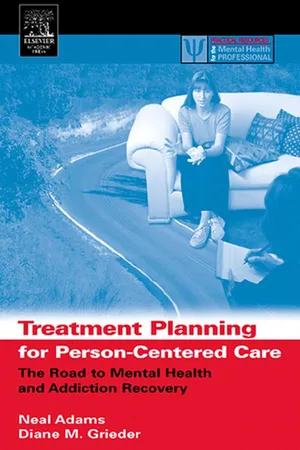
Treatment Planning for Person-Centered Care
The Road to Mental Health and Addiction Recovery
- 320 pages
- English
- ePUB (mobile friendly)
- Available on iOS & Android
Treatment Planning for Person-Centered Care
The Road to Mental Health and Addiction Recovery
About this book
Requirements for treatment planning in the mental health and addictions fields are long standing and embedded in the treatment system. However, most clinicians find it a challenge to develop an effective, person-centered treatment plan. Such a plan is required for reimbursement, regulatory, accreditation and managed care purposes. Without a thoughtful assessment and well-written plan, programs and private clinicians are subject to financial penalties, poor licensing/accreditation reviews, less than stellar audits, etc. In addition, research is beginning to demonstrate that a well-developed person-centered care plan can lead to better outcomes for persons served.* Enhance the reader's understanding of the value and role of treatment planning in responding to the needs of adults, children and families with mental health and substance abuse treatment needs* Build the skills necessary to provide quality, person-centered, culturally competent and recovery / resiliency-orientated care in a changing service delivery system* Provide readers with sample documents, examples of how to write a plan, etc.* Provide a text and educational tool for course work and training as well as a reference for established practioners* Assist mental health and addictive disorders providers / programs in meeting external requirements, improve the quality of services and outcomes, and maintain optimum reimbursement
Frequently asked questions
- Essential is ideal for learners and professionals who enjoy exploring a wide range of subjects. Access the Essential Library with 800,000+ trusted titles and best-sellers across business, personal growth, and the humanities. Includes unlimited reading time and Standard Read Aloud voice.
- Complete: Perfect for advanced learners and researchers needing full, unrestricted access. Unlock 1.4M+ books across hundreds of subjects, including academic and specialized titles. The Complete Plan also includes advanced features like Premium Read Aloud and Research Assistant.
Please note we cannot support devices running on iOS 13 and Android 7 or earlier. Learn more about using the app.
Information
Introduction to Getting Started
I. STATING THE CASE
The Process of Assessment
| Triage | A process of assigning priorities for access to treatment based on urgency and risk, typically but not necessarily used in emergency or crisis situations. |
| Screening | A cursory of preliminary assessment process for determining the need and appropriateness of services, often times used in initial determination of eligibility, level of care, and so on. |
| Assessment | An in-depth gathering of data and information, typically conducted at the initiation of treatment, needed to understand an individual’s or family’s needs as a pre-requisite for developing a plan of care. |
Establishing a Relationship
Organizing the Steps
Table of contents
- Cover image
- Title page
- Table of Contents
- Copyright
- Acknowledgments
- Prologue
- Foreword
- Preface
- SECTION I: Planning the Trip
- SECTION II: Getting Started
- SECTION III: On the Road
- SECTION IV: Journey’s End: The Destination
- Epilogue
- APPENDIX A: CHILD DIAGNOSTIC ASSESSMENT
- APPENDIX B: ADULT DIAGNOSTIC ASSESSMENT
- APPENDIX C: COUNTY MENTAL HEALTH—MULTIDISCIPLINARY INTAKE ASSESSMENT (RE-ADMISSION)
- Appendix D: PINE GROVE MENTAL HEALTH CLINIC INTAKE ASSESSMENT
- Index